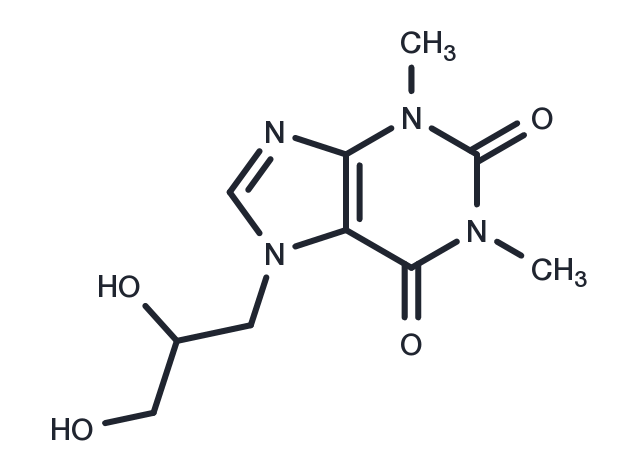Powder: -20°C for 3 years | In solvent: -80°C for 1 year


Diphylline (Diprophylline) is a xanthine derivative. Diphylline exerts bronchodilator effects and to a lesser extent vasodilator and diuretic properties. Diphylline probably acts as a competitive inhibitor of phosphodiesterase which leads to an increase in intracellular cAMP. This results in relaxation of bronchial smooth muscle and other smooth muscles. Diphylline may also antagonize adenosinereceptors. Diphylline is used in the treatment of acute bronchial asthma, chronic bronchitis and emphysema.

| Pack Size | Availability | Price/USD | Quantity |
|---|---|---|---|
| 50 mg | In stock | $ 44.00 | |
| 100 mg | In stock | $ 62.00 | |
| 500 mg | In stock | $ 179.00 | |
| 1 mL * 10 mM (in DMSO) | In stock | $ 68.00 |


| Description | Diphylline (Diprophylline) is a xanthine derivative. Diphylline exerts bronchodilator effects and to a lesser extent vasodilator and diuretic properties. Diphylline probably acts as a competitive inhibitor of phosphodiesterase which leads to an increase in intracellular cAMP. This results in relaxation of bronchial smooth muscle and other smooth muscles. Diphylline may also antagonize adenosinereceptors. Diphylline is used in the treatment of acute bronchial asthma, chronic bronchitis and emphysema. |
| Source |
| Synonyms | Dyphylline, Diprophylline |
| Molecular Weight | 254.24 |
| Formula | C10H14N4O4 |
| CAS No. | 479-18-5 |
Powder: -20°C for 3 years | In solvent: -80°C for 1 year
DMSO: 48 mg/mL (188.8 mM)
H2O: 47 mg/mL (184.9 mM)
Ethanol: < 1 mg/mL (insoluble or slightly soluble)
You can also refer to dose conversion for different animals. More
bottom
Please see Inhibitor Handling Instructions for more frequently ask questions. Topics include: how to prepare stock solutions, how to store products, and cautions on cell-based assays & animal experiments, etc.
Diphylline 479-18-5 GPCR/G Protein Metabolism Neuroscience Adenosine Receptor PDE P1 receptor Dyphylline inhibit Diprophylline Phosphodiesterase (PDE) Inhibitor inhibitor
